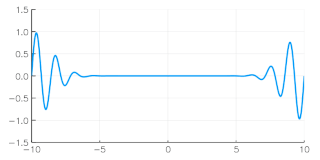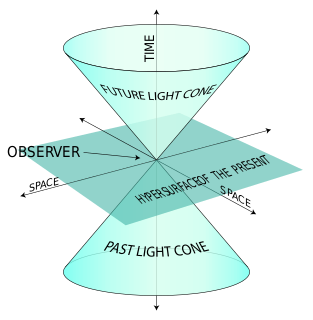
The phase velocity of a wave is the rate at which the phase of the wave propagates in space. This is the velocity at which the phase of any one frequency component of the wave travels. For such a component, any given phase of the wave will appear to travel at the phase velocity. The phase velocity is given in terms of the wavelength λ (lambda) and time period T as

In physics, special relativity is the generally accepted and experimentally well-confirmed physical theory regarding the relationship between space and time. In Albert Einstein's original pedagogical treatment, it is based on two postulates:
- The laws of physics are invariant in all inertial systems.
- The speed of light in a vacuum is the same for all observers, regardless of the motion of the light source.

In physics, spacetime is any mathematical model that fuses the three dimensions of space and the one dimension of time into a single four-dimensional continuum. Spacetime diagrams can be used to visualize relativistic effects such as why different observers perceive where and when events occur.

According to the theory of relativity, time dilation is a difference in the elapsed time measured by two observers, either due to a velocity difference relative to each other, or by being differently situated relative to a gravitational field. As a result of the nature of spacetime, a clock that is moving relative to an observer will be measured to tick slower than a clock that is at rest in the observer's own frame of reference. A clock that is under the influence of a stronger gravitational field than an observer's will also be measured to tick slower than the observer's own clock.
Sound pressure or acoustic pressure is the local pressure deviation from the ambient atmospheric pressure, caused by a sound wave. In air, sound pressure can be measured using a microphone, and in water with a hydrophone. The SI unit of sound pressure is the pascal (Pa).
Particle velocity is the velocity of a particle in a medium as it transmits a wave. The SI unit of particle velocity is the metre per second (m/s). In many cases this is a longitudinal wave of pressure as with sound, but it can also be a transverse wave as with the vibration of a taut string.
The moment magnitude scale is one of many seismic magnitude scales used to measure the size of earthquakes.

A sensor array is a group of sensors, usually deployed in a certain geometry pattern, used for collecting and processing electromagnetic or acoustic signals. The advantage of using a sensor array over using a single sensor lies in the fact that an array adds new dimensions to the observation, helping to estimate more parameters and improve the estimation performance. For example an array of radio antenna elements used for beamforming can increase antenna gain in the direction of the signal while decreasing the gain in other directions, i.e., increasing signal-to-noise ratio (SNR) by amplifying the signal coherently. Another example of sensor array application is to estimate the direction of arrival of impinging electromagnetic waves. The related processing method is called array signal processing. Application examples of array signal processing include radar/sonar, wireless communications, seismology, machine condition monitoring, astronomical observations fault diagnosis, etc.
Seismic anisotropy is a term used in seismology to describe the directional dependence of the velocity of seismic waves in a medium (rock) within the Earth.
Sonic logging is a well logging tool that provides a formation’s interval transit time, designated as , which is a measure of a formation’s capacity to transmit seismic waves. Geologically, this capacity varies with lithology and rock textures, most notably decreasing with an increasing effective porosity. This means that a sonic log can be used to calculate the porosity of a formation if the seismic velocity of the rock matrix, , and pore fluid, , are known, which is very useful for hydrocarbon exploration.
The surface wave magnitude scale is one of the magnitude scales used in seismology to describe the size of an earthquake. It is based on measurements in Rayleigh surface waves that travel primarily along the uppermost layers of the Earth. It is currently used in People's Republic of China as a national standard for categorising earthquakes.
The so-called Richter magnitude scale – more accurately, Richter's magnitude scale, or just Richter magnitude – for measuring the strength ("size") of earthquakes refers to the original "magnitude scale" developed by Charles F. Richter and presented in his landmark 1935 paper, and later revised and renamed the Local magnitude scale, denoted as "ML" or "ML". Because of various shortcomings of the ML scale most seismological authorities now use other scales, such as the moment magnitude scale (Mw ), to report earthquake magnitudes, but much of the news media still refers to these as "Richter" magnitudes. All magnitude scales retain the logarithmic character of the original, and are scaled to have roughly comparable numeric values.
In astronomy, interplanetary scintillation refers to random fluctuations in the intensity of radio waves of celestial origin, on the timescale of a few seconds. It is analogous to the twinkling one sees looking at stars in the sky at night, but in the radio part of the electromagnetic spectrum rather than the visible one. Interplanetary scintillation is the result of radio waves traveling through fluctuations in the density of the electron and protons that make up the solar wind.

Seismic inversion involves the set of methods which seismologists use to infer properties through physical measurements. Surface-wave inversion is the method by which elastic properties, density, and thickness of layers in the subsurface are obtained through analysis of surface-wave dispersion. The entire inversion process requires the gathering of seismic data, the creation of dispersion curves, and finally the inference of subsurface properties.
A laser surface velocimeter (LSV) is a non-contact optical speed sensor measuring velocity and length on moving surfaces. Laser surface velocimeters use the laser Doppler principle to evaluate the laser light scattered back from a moving object. They are widely used for process and quality control in industrial production processes.
A Track algorithm is a radar and sonar performance enhancement strategy. Tracking algorithms provide the ability to predict future position of multiple moving objects based on the history of the individual positions being reported by sensor systems.
The acoustoelastic effect is how the sound velocities of an elastic material change if subjected to an initial static stress field. This is a non-linear effect of the constitutive relation between mechanical stress and finite strain in a material of continuous mass. In classical linear elasticity theory small deformations of most elastic materials can be described by a linear relation between the applied stress and the resulting strain. This relationship is commonly known as the generalised Hooke's law. The linear elastic theory involves second order elastic constants and yields constant longitudinal and shear sound velocities in an elastic material, not affected by an applied stress. The acoustoelastic effect on the other hand include higher order expansion of the constitutive relation between the applied stress and resulting strain, which yields longitudinal and shear sound velocities dependent of the stress state of the material. In the limit of an unstressed material the sound velocities of the linear elastic theory are reproduced.

Inverse modeling is a mathematical technique where the objective is to determine the physical properties of the subsurface of an earth region that has produced a given seismogram. Cooke and Schneider (1983) defined it as calculation of the earth’s structure and physical parameters from some set of observed seismic data. The underlying assumption in this method is that the collected seismic data are from an earth structure that matches the cross-section computed from the inversion algorithm. Some common earth properties that are inverted for include acoustic velocity, formation and fluid densities, acoustic impedance, Poisson's ratio, formation compressibility, shear rigidity, porosity, and fluid saturation.
A seismic array is a system of linked seismometers arranged in a regular geometric pattern to increase sensitivity to earthquake and explosion detection. A seismic array differs from a local network of seismic stations mainly by the techniques used for data analysis. The data from a seismic array is obtained using special digital signal processing techniques such as beamforming, which suppress noises and thus enhance the signal-to-noise ratio (SNR).
Multidimensional seismic data processing forms a major component of seismic profiling, a technique used in geophysical exploration. The technique itself has various applications, including mapping ocean floors, determining the structure of sediments, mapping subsurface currents and hydrocarbon exploration. Since geophysical data obtained in such techniques is a function of both space and time, multidimensional signal processing techniques may be better suited for processing such data.
















